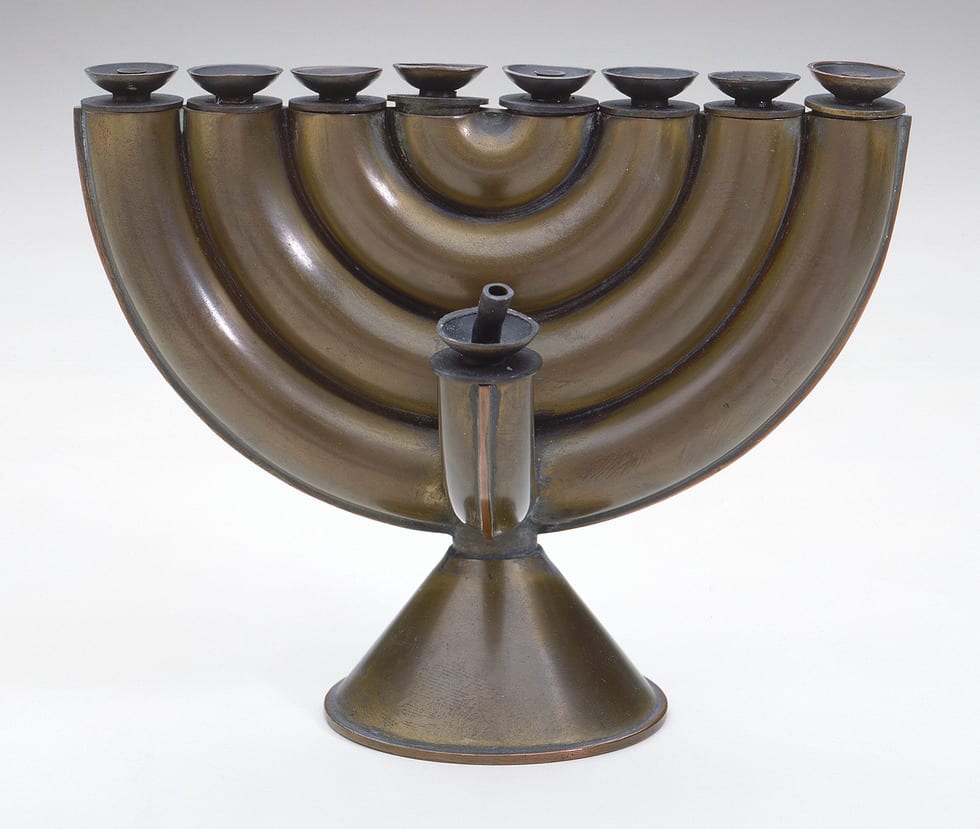
- Object Name:
- Hanukkah Lamp
- Artist/Maker:
- Ludwig Yehuda Wolpert
- Bio:
- b. 1900, Hildesheim, Germany; d. 1981, New York
- Place Made:
- Jerusalem (Israel)
- Date:
- 1950-55
- Medium:
- Copper alloy: repoussé
- Dimensions:
- 5 1/4 × 7 × 4 in. (13.3 × 17.8 × 10.2 cm)
- Credit Line:
- Gift of the Abram and Frances Kanof Collection of Contemporary Ceremonial Art
- Accession Number:
- JM 41-60
Not On View
Ludwig Yehuda Wolpert is regarded as one of the greatest Judaica artists of the twentieth century. His contribution to Jewish ceremonial art is tantamount to the role that the Bauhaus, Mies van der Rohe, Eric Mendelsohn, and other pioneers of the modern design movement played in changing the outlook of modern architecture and design. Wolpert reshaped a late-nineteenth-century art form that had looked to the past for its inspiration and infused it with the aesthetic spirit of the twentieth century.
Wolpert's artistic career began with private sculpture instruction and a program of study at the School of Arts and Crafts in Frankfurt, Germany. In 1925, he embarked on a three-year study of metalsmithing, which he then used to develop designs for Jewish ceremonial objects. By 1931, he had succeeded in combining his training and interests in the creation of a remarkable silver-and-ebony seder plate, that was first exhibited at the Berlin Museum of Arts and Crafts. The work was a radical step for ceremonial art as it employed a geometric functionalist style associated with the Bauhaus and modernism. It marked a turning point for Judaica. Wolpert's approach to his work was straightforward; the surface was kept plain so that the decoration did not overwhelm the object or detract from the beauty of the metal. The artist used conventional fabrication techniques to shape, pierce, and overlay his works. Elegantly proportioned and uncluttered, his work exudes a sense of the sacred and mystical, a quality that is palpable even to those unfamiliar with Jewish rituals or Judaica. Part of the remarkable "inner content" that the artist strived for in his work came from his encyclopedic and intimate familiarity with Jewish literature, history, liturgy, and symbolism.
Wolpert brought the same vitality to his designs for Hanukkah lamps -- a substantial collection of which is in The Jewish Museum. Particularly notable examples include a lamp from the early to mid-1950s, JM 41-60, which features bold arc-shaped segments that create a menorah form. Wolpert's sleek and simple design, and the inexpensive material from which the lamp is fashioned, copper alloy, reaffirmed his belief that good design should be relevant to people of today and should be readily affordable to every person. While the design of the lamp is bold and modern, the rich patination of the metal and the use of oil are references to the traditions of the past.
Wolpert became the first widely known artist to make ceremonial Judaica a life's work rather than the focus of an occasional commission. His pioneering work quietly revolutionized an entire genre.
Wolpert's artistic career began with private sculpture instruction and a program of study at the School of Arts and Crafts in Frankfurt, Germany. In 1925, he embarked on a three-year study of metalsmithing, which he then used to develop designs for Jewish ceremonial objects. By 1931, he had succeeded in combining his training and interests in the creation of a remarkable silver-and-ebony seder plate, that was first exhibited at the Berlin Museum of Arts and Crafts. The work was a radical step for ceremonial art as it employed a geometric functionalist style associated with the Bauhaus and modernism. It marked a turning point for Judaica. Wolpert's approach to his work was straightforward; the surface was kept plain so that the decoration did not overwhelm the object or detract from the beauty of the metal. The artist used conventional fabrication techniques to shape, pierce, and overlay his works. Elegantly proportioned and uncluttered, his work exudes a sense of the sacred and mystical, a quality that is palpable even to those unfamiliar with Jewish rituals or Judaica. Part of the remarkable "inner content" that the artist strived for in his work came from his encyclopedic and intimate familiarity with Jewish literature, history, liturgy, and symbolism.
Wolpert brought the same vitality to his designs for Hanukkah lamps -- a substantial collection of which is in The Jewish Museum. Particularly notable examples include a lamp from the early to mid-1950s, JM 41-60, which features bold arc-shaped segments that create a menorah form. Wolpert's sleek and simple design, and the inexpensive material from which the lamp is fashioned, copper alloy, reaffirmed his belief that good design should be relevant to people of today and should be readily affordable to every person. While the design of the lamp is bold and modern, the rich patination of the metal and the use of oil are references to the traditions of the past.
Wolpert became the first widely known artist to make ceremonial Judaica a life's work rather than the focus of an occasional commission. His pioneering work quietly revolutionized an entire genre.
Information may change as a result of ongoing research.